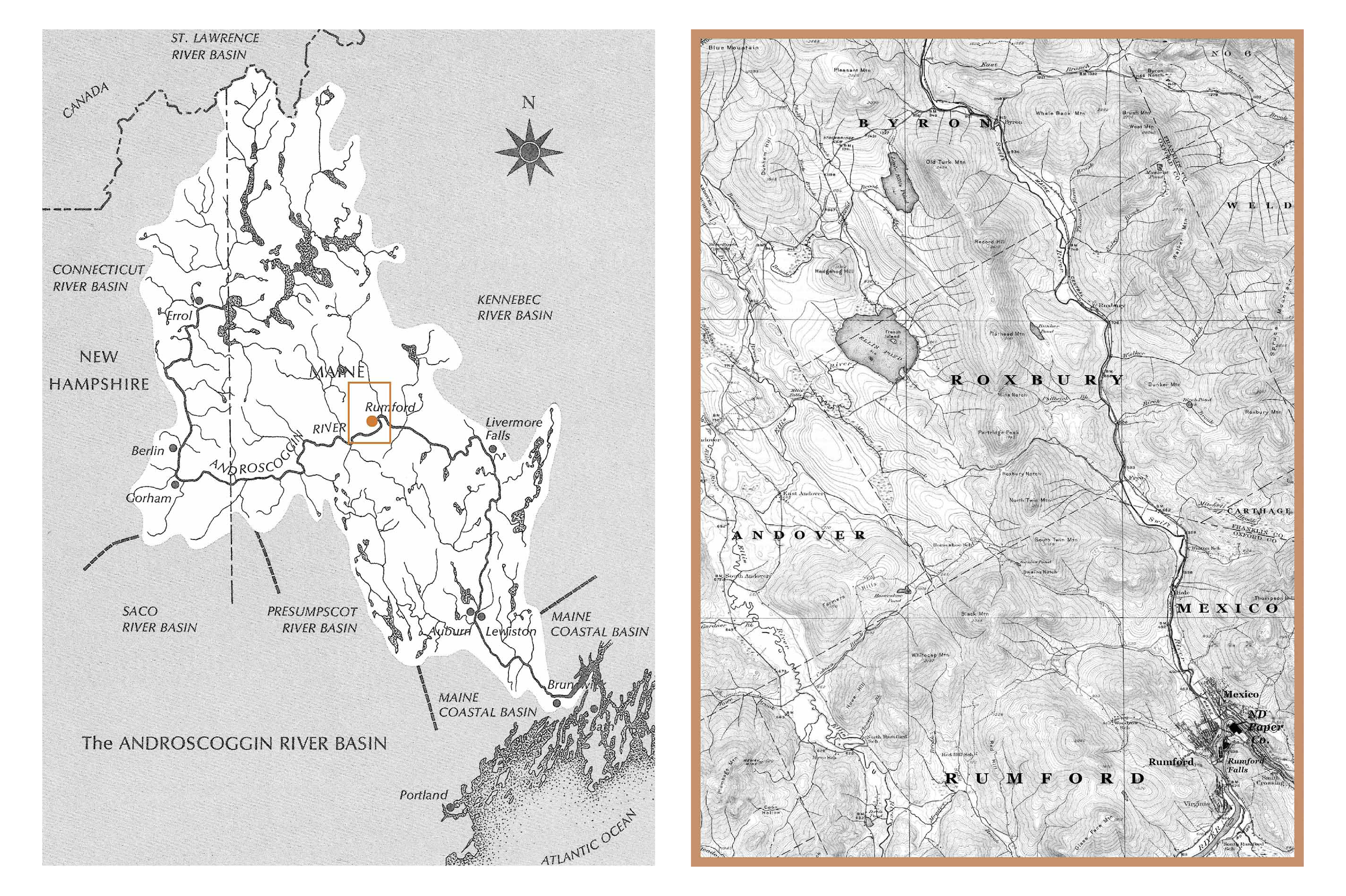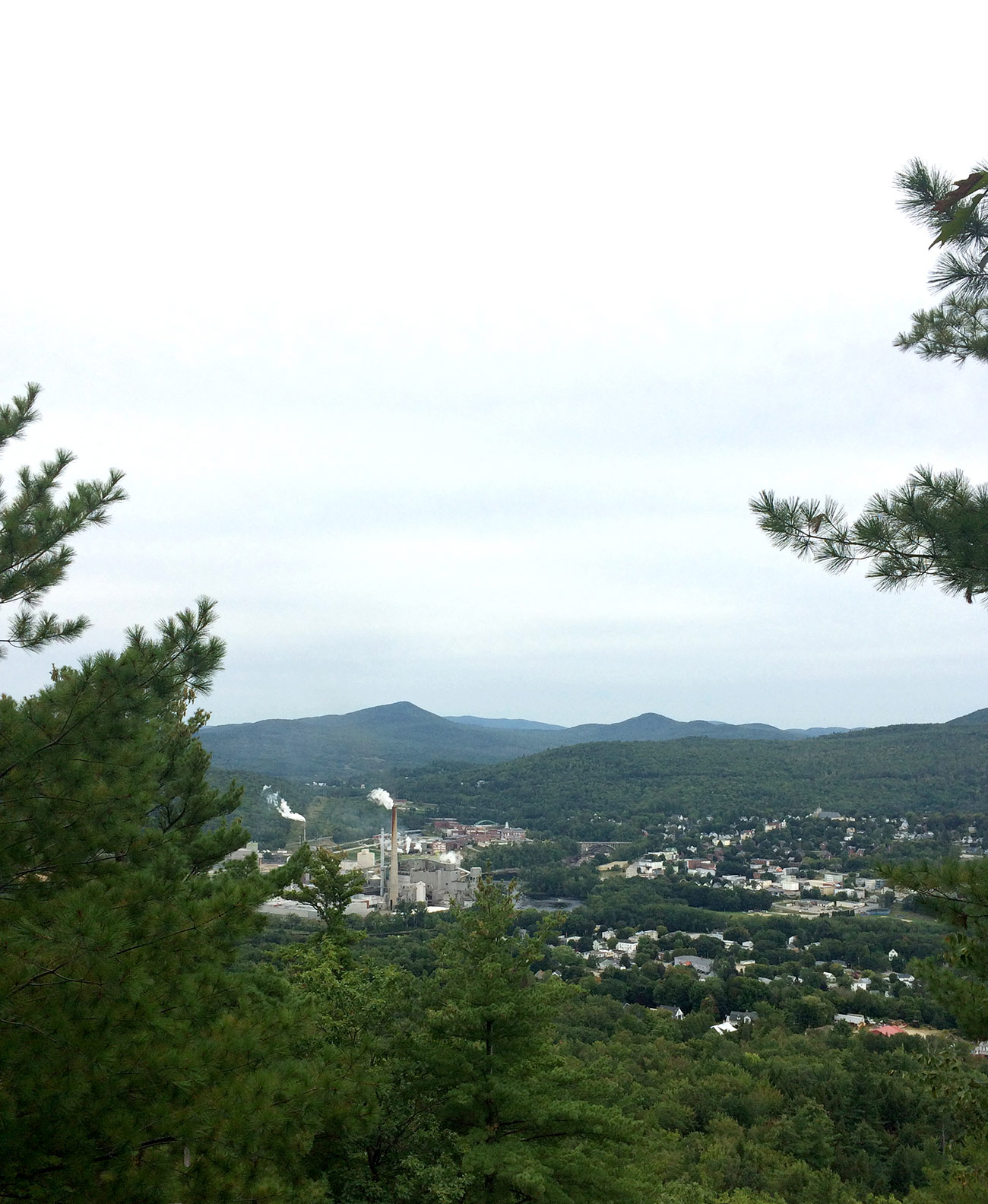River Valley, Maine
Maine’s River Valley: Labor, Landscapes, and Legacies
Maine’s River Valley is a rural community of nine working-class towns clustered within a valley of densely forested foothills, through which the Androscoggin River runs.1The River Valley includes the following Western Maine towns and a collective population of 14,519 people: Rumford (5,272), Mexico (2,681), Dixfield (2,475), Peru (1,541), Andover (818), Hanover (238), Canton (990), Roxbury (359), and Byron (145). In its center lies a paper mill that was once the world’s largest paper manufacturer under one roof.
The region’s natural resources should render it idyllic and exceptional among American landscapes: mountain springs, prized for their healing properties, that flow in tune with the moon; the river’s waterfall, which boasts a vertical drop rivaled in the east only by Niagara Falls; and mountains that provide a natural home for hikers, skiers, authors, campers, artists, fishermen, and musicians.
Yet from the late eighteenth century to the present day, the River Valley’s resources have been consistently extracted and abused. Brown trout and salmon were traded by Indigenous peoples for fur; the enchanted springs were marketed as tourist attractions; the waterfall was used for hydroelectricity; the trees were cut for paper; and townspeople were exploited by industry. Private capital and its interests have come to dominate the valley’s landscape. Atlantic salmon can no longer breach the numerous dams; land, restricted by corporations, is no longer publicly accessible; groundwater has been commodified by Nestlé, the largest food conglomerate in the world; and, most significantly, the region is overshadowed by the smokestacks of the paper mill—presently owned by the Chinese paper company Nine Dragons—and the cause, according to many residents, of 100 years’ worth of environmental and human offenses.

“Maine Timberlands” from Oxford Log, 1964. Rumford Historical Society. Credit: Image courtesy of Aaron Cayer and Kerri Arsenault.
This constant extraction of resources and environmental pollution, combined with over 50 years of other pressures—deindustrialization of rural America, the dehiscence of its working class, poverty, labor strikes, recessions, structural oppression, globalization, and rural isolation—has taken its toll on the community and its residents. Now, four out of five children are food insecure. The special education population is the highest in the state. The opioid crisis has ruined families and lives. People continue to die from cancer at alarming rates. In 2016, Rumford contained the highest rate of crime in Maine. And in October 2020, 100 of the paper mill’s 650 workers were laid off.
The River Valley is our hometown, and it serves as a microcosm for working-class communities across America. It illustrates the entrapments of the increasingly voiceless industrial laborers working in a postindustrial age—how they are involved in the very thing that may be ruining their landscape and their lives—and it offers a powerful view into the challenges associated with uplift and enfranchisement. The paper mill’s smokestacks struggle to lift the sour sulfur smell beyond the tips of the worn mountains, enveloping the community in just enough money for survival and just enough pollution to harm or kill its workers before retirement.
Indeed, the Valley has earned the national title Cancer Valley, although health experts, doctors, and elected officials are muzzled by industry-sponsored environmental studies that claim “inconclusive.” Our town also reflects the structural inequalities of wealth and how birthplace determines an individual’s destiny or death.
Drawing on active relationships with local residents, activists, writers, business leaders, and town officials, the features within this report explore the following questions: How does a machine-age mill community thrive in an age of postindustrialization and global corporate profiteering? How might local residents find solidarity with other workers, activists, or communities whose concerns intersect with their own? With or without the paper mill, how might the community identify itself? How might the community celebrate and amplify its natural resources without losing them to the grips of profit-seeking capitalists?
This report is framed by lived experiences, and it weaves together both “inside” views of the community—those of our families and neighbors—as well as “outside” views and interpretations constructed by contributors studying the region for the first time, in order to simultaneously examine the River Valley’s public face and its most intimate lived realities. Our contributions to this report draw from interviews with locals, our own experiences, and archives and historical documents in order to describe the ideological, environmental, and health consequences directly associated with the paper mill, the landscape, and life in the town. We include literary critic and author John Freeman’s text “Body” to frame the report, since it considers the simultaneity of power, fragility, and politics that bodies represent. Artist and researcher Nina Elder examines and then reinterprets archival photographs of the community’s industrial development by erasing the built environment altogether—creating “Present Ghosts”—and re-focuses our attention to the landscape. Media artists Steve Norton & N.B.Aldrich record the infrastructural sounds of River Valley, including the natural springs and rivers, as well as the roads, bridges, and mill in order to reveal two contrasting versions of one of the valley’s towns, Rumford: one whose infrastructure is embedded in and designed to celebrate nature, and the other whose infrastructure is characterized by modern industrial development. Artist and architect Tom Leytham traverses the region in order to document the “Other Working Landscape”—the abandoned, decaying, and fragmented ruins of the industrial past and present—through a series of watercolor paintings. And finally, Elizabeth Kaney and Kerri Arsenault reconsider the tourist maps provided at the town’s information booth by memorializing sites that are often left out of its public-facing narrative—of loss, extraction, pollution, and catastrophe.
Timeline of the River Valley
–1779: Township granted, named “New Pennacook Plantation”
–1800: Town of Rumford incorporated
–1826: Mineral spring business founded at Mount Zircon
–1901: Oxford Paper Company established
–1902: Strathglass Park, designed by Cass Gilbert, constructed for worker housing
–1903: First worker strike at Oxford
–1908: Paper companies in River Valley and Northeast US strike
–1921: Paper companies across US strike; workers lose homes, jobs, and union membership declines
–1967: Ethyl Corporation purchases the paper company
–1976: Boise Cascade purchases the paper company
–1980: Worker strike at Boise Cascade
–1986: Worker strike at Boise Cascade; workers permanently replaced
–1987: Worker strike at International Paper in nearby Jay; workers permanently replaced
–1991: River Valley christened as “Cancer Valley”
–1996: Mead Corporation purchases the paper company
–1998: Forestry industry-sponsored study of paper mill mortality published; proves “inconclusive”
–2005: NewPage purchases the paper company
–2011: Maine Governor Paul LePage removes Maine labor history mural from State Labor Department
–2015: Catalyst Paper purchases the paper company
–2018: Nine Dragons Paper purchases the paper company
–2019: Poland Springs (Nestlé) begins drilling for water in Rumford
Throughout, we provide historical and ethnographic context about the mill’s history and the community in order to provoke difficult questions about the future of the River Valley. While this report offers critical insight into the community, including the ways in which its history compares to and is shaped by those of other working-class industrial towns, as well as histories and theories of class, labor, and politics more broadly, the features collectively seek to amplify the voices and concerns of those who call the River Valley home.
Like our story of returning to the River Valley after growing up there, in his 1960 book Border Country, cultural theorist and novelist Raymond Williams tells the story of an academic who returns to his rural hometown village, Glynmawr, located in the Black Mountains near the coal mining valley of South Wales, to visit his sick father. While the text is fiction, Williams’ flashbacks to the 1920s and 1930s reveal connections to his own life, and throughout the text, dualities characterize his narrative and the life of his protagonist. The town is a familiar home and a touristic non-home; he is an insider and outsider; he sees both “place” and landscape; he is a local, but also participates in global spaces of discourse and exchange.
In the production of this report, we recognized the different structures of feeling that are embedded in a community. The touristic gaze from the outside does not supplant the lived experiences of inhabitants, since the values that define and attach to a people and an environment are shaped through work, play, rituals, and cultural practices over extended periods of time.
This report seeks not to challenge this duality, but instead to highlight and recognize how it changes based on one’s perspective. We ask how might we, as both insiders and outsiders, make visible the various ways in which outside forces shape local views and experiences—including the global corporate powers of the paper mill—through which the community produces itself? And at the same time, how do the local workers, community members, and their contributions to the world explain broader politics of working-class towns beyond the River Valley? Williams describes the experience of returning home after leaving, which characterizes our own:
It was one thing to carry its image in his mind, as he did, everywhere, never a day passing but he closed his eyes and saw it again, his only landscape. But it was different to stand and look at the reality. It was not less beautiful; every detail of the land came up with its old excitement. But it was not still, as the image had been. It was no longer a landscape or a view, but a valley that people were using. He realized as he watched, what had happened in going away. The valley as landscape had been taken, but its work forgotten. The visitor sees beauty: the inhabitant a place where he works and has friends. Far away, closing his eyes, he had been seeing this valley, but as a visitor sees it, as the guide book sees it: this valley, in which he had lived more than half his life.2Raymond Williams, Border Country, (London: Hogarth Press, 1988), 75.
In going away, Williams argues, it was the work, the people, the friends, and the neighbors that were forgotten—the very things that made the town a “place.” Our return to home (in part, via this report) confronts those conundrums and helps illuminate the ways in which our connections to home and landscape are like ongoing dialogues between people in deep and complicated relationships.
Kerri Arsenault narrates a slideshow of images introducing Maine’s River Valley.
All photographs by Kerri Arsenault or the Arsenault family.
Biographies
is an architectural historian and assistant professor of architecture history at the University of New Mexico. He was raised and educated in the town of Rumford, Maine—the largest of those within the River Valley. He left Rumford for college after graduating from Mountain Valley High School. Cayer studied architecture at Norwich University in Vermont, where he earned undergraduate and graduate degrees, as well as at UCLA, where he received his Ph.D. in architecture history.
grew up in the River Valley, and she is a book critic, the book review editor for Orion Magazine, contributing editor at The Literary Hub, and author of Mill Town: Reckoning with What Remains. She received her MFA from The New School and studied in the graduate program in Communication for Development at Sweden’s Malmö University. Her work has appeared in The Boston Globe, The Washington Post, Air Mail, Freeman’s, the Paris Review Daily, and the New York Review of Books.
The views expressed here are those of the authors only and do not reflect the position of The Architectural League of New York.



